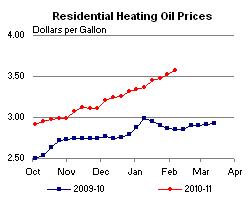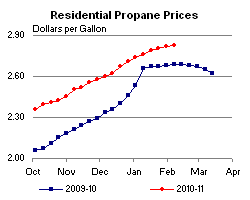Released: February 9, 2011
Next Release: February 16, 2011
The Art of Understanding Weekly Variations in Product Supplied Estimates
Readers who follow the U.S. Energy Information Administration’s (EIA) weekly product supplied estimates for gasoline, distillates, kerosene-jet fuel, residual fuel oil, and propane in the Weekly Petroleum Status Report (WPSR), could be tempted to read too much into the week-to-week fluctuations reported for those products. For example, does a one-week increase in distillate product supplied of 400,000 barrels per day necessarily indicate that the Nation’s consumption of distillate fuels has suddenly skyrocketed compared to the prior week? Maybe, but not necessarily. This issue of This Week In Petroleum highlights some of the factors that underlie EIA’s weekly product supplied estimates to help readers better understand why some products may show relatively large weekly swings and suggests a broader, more relevant context for considering these estimates.
Weekly Petroleum Status Report users should first keep in mind that this publication offers a weekly estimate of petroleum products that were supplied to the U.S. domestic market. For any given product, EIA’s product supplied estimate is calculated as the net barrels made available to the economy from that week’s production and imports, minus any change in that product’s stock level from the prior week, and less a model-based estimate of exports of that product. Because EIA does not directly survey domestic petroleum end-use consumption, the WPSR’s product supplied estimates serve as a proxy for weekly consumption. And while product supplied is a good proxy for consumption, supply data can fluctuate more on a weekly basis than actual consumption, since product supply estimates include stocks moving between the various levels of the supply chain. These movements include transfers from primary storage at refineries, pipelines, and bulk storage terminals—where stock levels are reported by WPSR respondents—into secondary storage for further distribution to end users.
For example, a refinery might decide to move a larger-than-normal amount of product to a distributor’s secondary storage facility in Week 1, resulting in a larger-than-normal reduction in primary stock levels. Thus, it might appear that an increased amount of product was “consumed” in Week 1, followed by a drop in “consumption” the next week if less of that product is moved out of primary inventory for that same distributor in Week 2. In this simplified example, based solely on the reported changes in stock levels each week, it might initially appear that “consumption” for this product dropped considerably from Week 1 to Week 2, when it was actually just the result of a refiner’s business decision to move this product out of primary storage over one week rather than two. In this case, using a two-week average to view the impact of aggregate inventory changes would likely provide a better estimate of product supplied (as a proxy for consumption) over the entire 14-day period.
Another key factor affecting weekly variations in product supply estimates is the impact of timing on respondents’ WPSR reporting. All WPSR respondents are instructed to report their weekly activities, including pipeline/terminal product inventories as well as imports, refinery operations, blending activities, and ethanol production, as of Friday at 7:00 a.m. Eastern Time. For imports in particular, it is easy to see how an incoming vessel that just misses clearing U.S. customs by EIA’s Friday 7:00 a.m. reporting deadline can affect the product supplied estimates for a given week.
In this hypothetical case, assume a vessel bringing in 300,000 barrels of gasoline is scheduled to arrive Friday morning during Week 1, but is delayed by fog and does not clear customs until 7:05 a.m. Since this vessel did not meet EIA’s Week 1 reporting deadline, it would not be included in that week’s gasoline product supplied estimate, but would instead be included with imports that determine gasoline product supplied during Week 2. The impact of this five-minute delay (along with any other vessels arriving on Friday shortly after 7:00 a.m.) would lower gasoline product supplied in Week 1 and raise it in Week 2. During weeks when a number of vessels arrive either just before or just after the weekly reporting deadline, week-to-week product supplied estimates can swing more wildly than might be expected. Again, using a two-week or longer moving average would give WPSR users a more complete context for reviewing the product supply situation over the relevant period. This is why the WPSR includes four-week moving averages for many of the statistics, including product supplied.
The examples above highlight the peril of attempting to draw overly broad conclusions based on changes from one week to the next in the WPSR weekly petroleum product supplied estimates. While every week’s data adds to the set of relevant and important information for discerning market trends, one week’s report, by itself, is not sufficient to distinguish between the beginning of a new trend, the end of an existing trend, or simply a one-week anomaly. Similar to the deeper understanding that comes when we step back from an impressionist painting whose details we may have been focusing on too intently, the WPSR’s fuller image often comes into clearer view when we examine the broader picture.
Retail Diesel Price Surges While Gasoline Increases Three Cents
Following the first decline in nine weeks, gasoline prices rose again this week with the U.S. average retail price advancing three cents versus last week to $3.13 per gallon, $0.48 per gallon higher than last year at this time. Prices in the Rocky Mountains jumped five and a half cents, the biggest increase in the country. Both the Midwest and Gulf Coast saw prices up almost four cents from last week. Gasoline on the West Coast increased more than three cents, while the increase on the East Coast was more modest with the price less than two cents higher compared to last week. Gasoline is least expensive on the Gulf Coast where the average price is $2.97 per gallon. The West Coast continues to have the highest prices in the country at $3.33 per gallon.
Diesel prices surged ahead this week with the national average retail price adding more than seven cents to last week’s price. At $3.51 per gallon, diesel is $0.74 higher than last year at this time. Diesel on the West Coast jumped nearly a dime versus last week’s price. This was the largest one week increase for any major region since October 2009, and kept the West Coast the most expensive region in the country at $3.63 per gallon. The Midwest diesel price gained eight cents on the week, followed closely by both the Gulf Coast and East Coast where prices advanced over seven cents. The Rocky Mountain diesel price increased six cents for the week. The New England sub-region and California now have diesel prices over $3.70 per gallon.
Residential Heating Fuel Prices Increase
Residential heating oil prices continued to rise during the period ending February 7, 2011. The average residential heating oil price increased to $3.58 per gallon, over $0.05 per gallon above last week and $0.73 per gallon more than last year at this time. Wholesale heating oil prices increased by under $0.01 per gallon last week, reaching a price of $2.81 per gallon. This is nearly $0.84 per gallon higher than last year’s price.
The average residential propane price increased by nearly $0.01 per gallon to reach a price close to $2.83 per gallon. This was an increase of $0.14 per gallon compared to the $2.69 per gallon average from the same period last year. Wholesale propane prices decreased with the overall price at $1.41 per gallon. This was a decline of about $0.12 per gallon compared to the February 8, 2010 price of $1.53 per gallon.
Propane Stocks Decrease after Winter Storm
Approximately one-third of the U.S. population was affected by a large winter storm last week, resulting in another seasonal decline of propane inventories. Total U.S. stocks of propane fell 3.1 million barrels last week, ending at 34.8 million barrels in total. The Gulf Coast regional stocks fell by 1.5 million barrels and the Midwest region drew 1.1 million barrels of propane. The East Coast region drew 0.3 million barrels, while the Rocky Mountain/West Coast propane inventories fell by 0.1 million barrels. Propylene non-fuel use inventories represented 7.7 percent of total propane inventories.
Text from the previous editions of This Week In Petroleum is accessible through a link at the top right-hand corner of this page.
| Retail Prices (Dollars per Gallon) | |||||||
 |
 |
||||||
 |
 |
||||||
| Retail Data | Changes From | Retail Data | Changes From | ||||
| 02/07/11 | Week | Year | 02/07/11 | Week | Year | ||
| Gasoline | 3.132 | Heating Oil | 3.577 | ||||
| Diesel Fuel | 3.513 | Propane | 2.827 | ||||
| Futures Prices (Dollars per Gallon*) | |||||||||||||||||||||||||||
 |
 |
||||||||||||||||||||||||||
|
 |
||||||||||||||||||||||||||
| *Note: Crude Oil Price in Dollars per Barrel. | |||||||||||||||||||||||||||
| Stocks (Million Barrels) | |||||||
 |
 |
||||||
 |
 |
||||||
| Stocks Data | Changes From | Stocks Data | Changes From | ||||
| 02/04/11 | Week | Year | 02/04/11 | Week | Year | ||
| Crude Oil | 345.1 | Distillate | 164.4 | ||||
| Gasoline | 240.9 | Propane | 34.805 | ||||